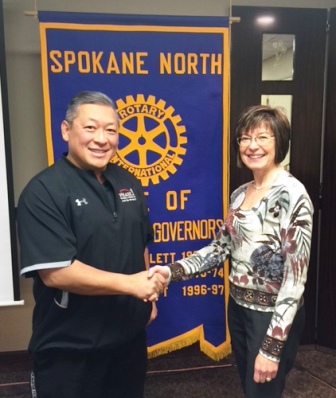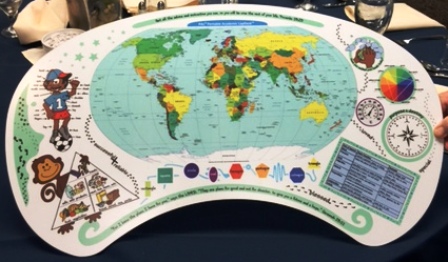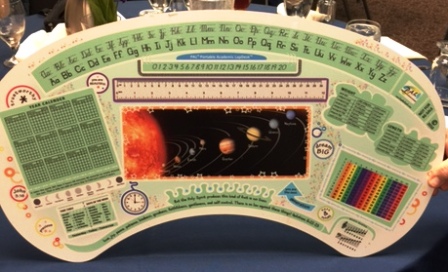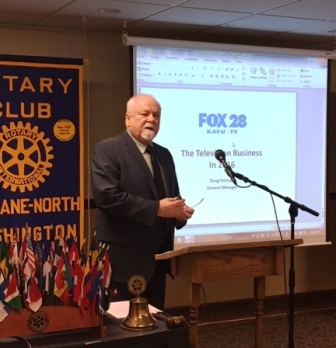Fos 28 TV - Doug Holroyd
Posted by Charles Rehberg
on Feb 22, 2016
Spokane North Notes
A weekly bulletin of the Spokane-North Rotary Club
February 22, 2016
Editors: Chuck Rehberg and Sandy Fink
Photos: Lenore Romney and Sandy Fink
Program Coordinator: Brad Stark

Welcome Joel!: The club’s newest member, Joel San Nicolas, was installed Feb. 22. Joel has been a physical therapist in the Suncrest-Nine Mile Falls area for 13 years. He also provides treatment for athletes from Lakeside High. Joel has beenactive in “Crutches for Africa,” a program to gather 3,000 pairs of crutches, wheelchairs and other mobility-assist devices which he and others plan to take to needy patients in Africa. Mark Visintainer was Joel’s sponsor for club membership.
Joel’s membership got off to a good start as he won the weekly sergeant-at-arms drawing.
Strategies, cont.: As planned, club members took a few minutes Feb. 22 to continue planning for the fund raising efforts for needy children at Holmes School and elsewhere in the West Central and near North Side areas. Fund-raising coordinator Jodi Harland said she tries to talk with potential corporate donors before sending them the letter inviting their participation. She has sent copies to each member. The strategy sessions with four teams of members will continue every other week.
Funds leveraged to help global PALs
Turning a $500 contribution from our club into part of a $41,000 Rotary Foundation global grant is “a magic act,” said club President Lenore Romney.
 One of the “magicians” on point – former District Gov. Lloyd Gray – visited the club Feb. 22 to show and tell about one of the “Portable Academic Laptop (PALs) and describe the amazing reach of the program.
One of the “magicians” on point – former District Gov. Lloyd Gray – visited the club Feb. 22 to show and tell about one of the “Portable Academic Laptop (PALs) and describe the amazing reach of the program. Spokane Club 21 is leading the grant-writing effort. It donated a few thousand dollars last year toward project development and has pledged $10,000 this year. Spokane-North, along with Spokane South, Spokane East, Spokane Valley and Aurora Northwest clubs have each pledged $500 to grow the project.
Part of the “magic act” is showing support from several area clubs to obtain district and RI matching funds and other monies. Gray said total funding should reach $41,000 for the lapdesk project this Rotary year. The global grant would be the
area’s first in about 20 years.
The PAL units are lightweight, watr-proof, curved anodized aluminum sheets. The shape accommodates rural grade school students sitting outside on the ground or on chairs. A Spokane business, Signs for Success, produced the prototype units.
Gray said the total funding would buy 1,260 lapdesks which would be cycled through elementary school classrooms to as many as 18,000 students a year in Malawi. Given the 10-year expected life of the lapdesks, the units could be used over time by some 180,000 students.

Each unit has graphics and data printed on both sides, offering 16 types of lessons, from math and language to geography and the planets. Club members passed around the prototype and a course outline. Gray said two more lessons – one on HIV AIDS and another called “keeping the girls in school” – are being added to the lesson plans.
The project was launched four years ago by Joel and Jackie Wells, Spokane missionaries who have worked in southern Africa for nine years. The Welles say there are 70 million children, ages 6 to 12, in a five-country region, who have little or no instructional materials in their rural schools. Student-teacher ratios often are 100-1, according the the PALs website.
The first target area is Malawi, Africa, where English is the official language. Helping with distribution and oversight, Gray said, will be the Bwaila-Lilongwe, Malawi Rotary Club. Aurora Northwest Club has expressed interest in adding Kenyan schools to the program. Other countries targeted for PALs units include Uganda, Zimbabwe and northern Mozambique.

As of last November, some 1,170 PALs units have been distributed, reaching more than 20,000 students, the website says.
Gray said the test use of the lapdesks showed remarkable increases in class attendance and participation, language and math skills and other positive indicators. He hopes the program can grow in succeeding years. “The more we can get teaching aids into more schools, the better,” Gray said.
Get the picture? – a broadcast history
 Doug Holroyd, general manager of KAYU-TV FOX 28, said in his lifetime he has gone from “sitting in the living room listening to the radio” to a digitized world of broadcast, cable and internet streaming of high definition television. He shared his amazing trip with the club Feb. 22.
Doug Holroyd, general manager of KAYU-TV FOX 28, said in his lifetime he has gone from “sitting in the living room listening to the radio” to a digitized world of broadcast, cable and internet streaming of high definition television. He shared his amazing trip with the club Feb. 22. Holroyd also has been g.m. of FOX affiliates in the Tri-Cities and Yakima for four years. His 20-year broadcast management career includes stops in Sacramento and Eureka, Calif., and oversight of FOX, CBS, CW, MY Network, Univision, Telemundo and Telefutura networks. He said he has just added Telemundo to broadcast operations in the heavily Spanish-speaking Yakima Valley.
Holroyd, a guitar and bass player, also has been a music producer for concerts, TV shows, movies and recordings and has owned music stores in Modesto and Fresno, Calif.
His trip down memory lane included a brief TV history, starting with Philo Farnsworth – then a high school student in Idaho – inventing television in 1927. “With 60 lines of resolution, it was like watching through partly-opened blinds,” Holroyd said.
While the resolution increased, the next big step was color television in 1953. Holroyd said critics at the time said “color would not last, because TV was a black-and-white medium.” Despite Alfred Hitchcock’s best efforts, color prevailed.
Holroyd said rear-screen projection in 1985 was another big advancement, but not much changed – other than cable TV’s proliferation – until high-definition transmissions in 2009.
Then a manager in Eureka, Holroyd volunteered that small market as a high-def beta site, “but nobody could see us.” To ensure enough area viewers could watch that programming, he said everyone at his station, from the secretaries on up, went door-to-door to distribute “truckloads” of converter units or $40 gift cards so viewers could buy converters. At stake was the “sweeps week” ratings which set future ad rate revenues. Viewership was just fine, he said.
So now that analog transmission has given way to the digital age, and bandwidth space has been compressed, Holrod posed the rhetorical question: “What’s next?”
Perhaps “4K” transmissions, so vibrant “viewers feel like they could walk right into the screen.” Or perhaps it will be 3-D TV or holograms, he said.
Holroyd said viewers now average 5.3 hours a day of television and many younger viewers have laptop computers or cell phones in hand while watching, ushering in an interactive dimension. Many, including Holroyd himself, have “cut the (cable) cord,” using small antennas for local reception and subscription services, such as Hulu and Netflix, to stream other program content. He even punched up the FOX transmission on his cell phone to demonstrate that “app.”
Since streaming and “social media” interactions affect viewership, rating services now use “day-of, day of-plus three and seven-day” viewing segments to record usage, Holroyd said.
The Inland Northwest market, he said, covers 24 counties in four states, “one of the biggest service areas in the country.” The expanded area contains 1,000,015,000 people, and, given average viewing habits, some 2 billion hours of TV watching per year, Holroyd said.
Of the 210 TV markets in the U.S., Spokane ranks 73rd largest and Yakima-TriCities in number 123, he said.
In his broadcasting life, he said, TV has gone from three networks to 452 networks, “and that’s only counting English.”
Describing the impact of election years, Holroyd said candidates’ ads must be billed at the lowest rates “and that hurts our business, because other advertisers would pay more.” However, higher rates can be charged for “issue ads,” such as recent campaigns for and against legalizing marijuana use, private-store liquor sales and same-sex marriage.
Holroyd’s presentation was the first of several club programs on mass media.
